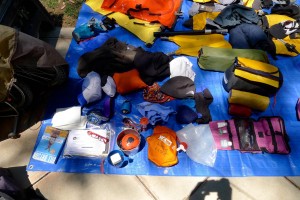
Camping gear suitable for comfortable self supporting has taken a great strides forward in the past couple of decades with the continuing popularity and development of the ultralight hiking movement. While, keeping your boat as light as possible may not be as critical as with long distance hiking, the reduction of size and weight of necessary camping items pays dividends when loading stow floats or making portages. Much of this light gear, including waterproof stuff sacks, has gone mainstream and is readily available in good camping equipment stores. Most of my kayak camping gear is the same that I now hike with.
SHELTER
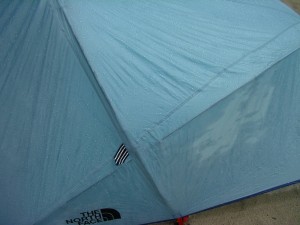
Many good shelter options exist for the overnighter, depending on weather and environment. On my first multi day, the three of us slept under a single rainfly, each in his own bivouac bag, heads tucked securely under the cover. This is a fine and flexible option for alpine floats, whereupon every boater becomes sufficient unto himself, while still retaining some communal arrangement. Single pole, floor-less canopies which can be extended to the ground can improve weather tightness during storms.
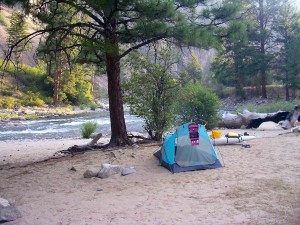
In warmer, desert climes bivouac bags become too confining and warm, offering little protection against wind storms, blowing sand, and insects. I used a small two person three pole catenary tent with great success for years on river, only recently replaced by the new generation of lighter and smaller single person type. Advances in tent design have now made one person self supporting tents entirely suitable for all overnights. With the addition of a communal rainfly/shelter cooking tent, a comfortable camp for all can be made.
SLEEPING BAG
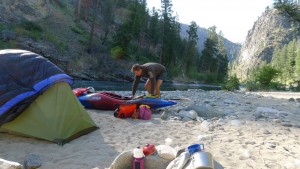
Boating primarily in the West and Southwest, I prefer goose down sleeping bags for their ultimate lightness and compressibility. There are now many good manufacturers of such bags, thanks in large part to the aforementioned ultralight movement. A full length zipper will allow the bag to be used comforter style on warm nights. I appreciate their liabilities when wet, but the fact is that my bags have never become wet. Don’t depend on your stow floats alone to keep critical gear dry, no matter how good you think they are. Here is a technique for ensuring your bag will remain dry on river, that I discovered long ago. I use a small to medium size roll type waterproof dry bag instead of a stuff/compression sack. Though very light ones are made of hi-tech fabrics these days, I still use medium weight roll tops made of waterproof, welded seam nylon. The roll closure will not only seal the opening but enable a two pound plus bag to be squished down to the size of a loaf of bread without further expansion. The combination dry bag and stow float is the functional equivalent of having your bag protected by two dry bags. Use small dry bags within your stow floats, or storage compartments, for any gear which must remain dry. I use at least one clipped into my seat containing my water filter, protecting it from river water.
SLEEPING PAD
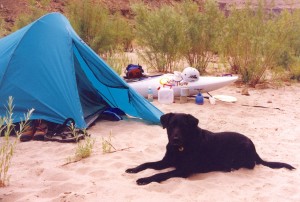
Time was when sleeping on the ground didn’t require much insulation or cushion and I could sleep comfortably on a sandy beach with nothing more than a groundcloth. Ancient history aside, I began kayak camping with a thin three quarter length self inflating style pad. Rarely needed on sun warmed sand was additional insulation under my feet, but extra clothing served that function well when required on other surfaces. I would shove the bottom half of my PFD under the floor of my tent at the head end to serve as a pillow, raising my head to quite a comfortable position. I’m a big believer in multiple uses when appropriate, and space and weight are at a premium.
The air mattresses of old have undergone a radical evolution in recent years. Everything old is new again (except for me), and I now much prefer these new fangled air pads for their sumptuous cushioning and increased insulation over self inflating foam mattresses. A full length version packs smaller and weighs less than my old three quarter system – enough so that I now include a small inflatable pillow as well. Extra clothing may now be worn when needed, rather than placed beneath my feet on hard ground, and the PFD now sleeps with the boat. Getting these new air mattresses wet holds little significance anymore.
WATER TREATMENT
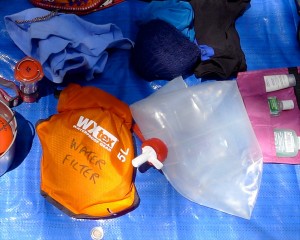
Water filtration, once a truly loathsome chore, has become significantly less taxing within only the last couple of years with the introduction of squeeze and gravity feed hollow fiber membrane technologies. These field cleanable units are both lighter and smaller than any of the old pump style filters. The regular ones filter all important bacteria, protozoa and viruses one is likely to encounter in everywhere but third world countries, with lifetime lifespans. I use the large gravity/reservoir systems in camp, and the squeeze filters on river.
Additional care must be taken on all heavily silted rivers to allow sediment to settle before filtering to prevent clogging of the filter. This is where a collapsible water bucket becomes of great use. It is just as useful at camp on clear rivers, allowing one to filter conveniently from it rather than directly from the river. Obtaining water from side streams is an even better option, when available.
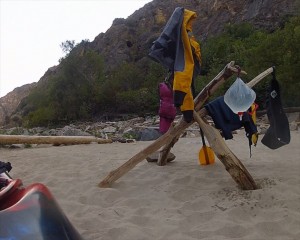
Chemical treatments to purify water are favored by some, if taste is not a consideration. These take some time to act on impure water. UV pens work as well for smaller volumes of water, but can be a bit finicky and unreliable in operation. Of course, boiling water works, but takes a great deal of energy either from gas stoves or fires, necessitating the use of firepan and ash transport. Add to this the time required time to cool down, and this can be quite an inconvenient strategy while paddling. A inexpensive collapsible water container will not only allow you to collect sufficient clean water, but also to dispense it via gravity feed, easing camp chores quite a bit.
Keeping sufficiently hydrated on desert rivers, as in the American Southwest, can prove especially challenging while paddling. I have typically kept my collapsible gallon and a half water container, normally intended only for camp, partially filled with filtered water within my boat, or on my lap. In calmer waters it has been carabinered to a rescue D-ring on my boat’s front deck. Though I have yet to put it to the test, the promise of on demand filtration from small and “sip-able” filters may obviate that less than desirable requisite.
COOKING / FOOD STORAGE
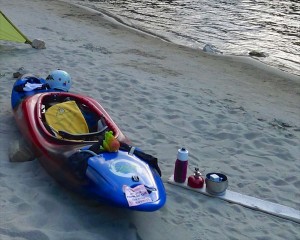
Gas backpacking stoves are the ticket to hassle free camp meals. Sure, you can cook over a fire – if you want to deal with the ashes afterward where fires are controlled. I’ve used an ultralight pressurized gas canister model with a piezoelectric lighter forever. Advances in a new generation lighter weight, cleaner, wood burning stoves are being made all the time. If you are willing to deal with the ash, this may be a compromise to having open fires and cooking needs. In any case you’ll still need a fire blanket and fire pans on some rivers. For now, I’ll stick with the convenience and cleanliness of canned gas. I bring the largest pot I can get through the seat to rear deck aperture choke point. It is the smallest pot I have. You can see how this restriction sustains any reticence to boil water as a convenient method of water treatment.
Plan your meals so there is as little waste as possible, and remove excess packaging/repackage before leaving home. Zip Lock style bags have absolutely revolutionized food packaging on the river, and elsewhere. I only use the heavyweight “freezer” style for their certain robustness. These things are going to get squished ten ways from sundown before you empty their contents. Those mature enough will remember the barely effective twist tie bag closures of old. They were a plague upon the landscape nearly as ubiquitous as soda/beer can pull tabs. Even today, I continue to find this antediluvian detritus on every supposedly pristine beach camp I visit on rivers which have had visitation controls for decades. Odor proof bags may be used to control food odors where raiding wildlife is a concern.
ENTERTAINMENT
What? Paddling wilderness rivers isn’t enough entertainment for you? All manner of tablets and phones now have a plethora of entertainment options, if you can keep them charged. Whether that is possible with small solar chargers depends on the amount of time one can devote to keeping chargers exposed to the sun. Chief among recent substitutions to my self support list is that I no longer carry a book. Rather, e-readers provide virtually unlimited reading material with less space and weight. The self lit glow types provide even more convenient late night reading, without headlamps, if one can deal with the occasional insect lighting upon the screen and turning pages for you. Some travelers have loaded audio books on small devices for an even lighter weight and more hands off “reading” experience.
